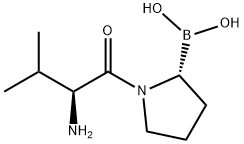149682-77-9
 149682-77-9 结构式
149682-77-9 结构式
基本信息
TALABOSTA
talabostat
VAL-BORO-PRO
Unii-kz1o2sh88z
Talabostat (PT100)
Talabostat (Val-boroPro, PT-100)
PT-100
VALBOROPRO
VAL-BOROPRO
PT100
PT 100
[(2R)-1-[(2S)-2-amino-3-methylbutanoyl]pyrrolidin-2-yl]boronic acid
[(2R)-1-[(2S)-2-Amino-3-methyl-1-oxobutyl]-2-pyrrolidinyl]boronic acid
物理化学性质
常见问题列表
IC50: < 4 nM (DPP-IV), 4/11 nM (DPP8/9), 310 nM (QPP), 560 nM (FAP)
Ki: 0.18 nM (DPP-IV), 1.5/0.76 nM (DPP8/9)
By cleaving N-terminal Xaa-Pro or Xaa-Ala residues, Talabostat (Val-boroPro) inhibits dipeptidyl peptidases, such as FAP, resulting in the stimulation of cytokine and chemokine production and specific T-cell immunity and T-cell dependent activity.
Talabostat (Val-boroPro) competitively inhibits the dipeptidyl peptidase (DPP) activity of FAP and CD26/DPP-IV, and there is a high-affinity interaction with the catalytic site.
Talabostat (Val-boroPro; PT100) can stimulate immune responses against tumors involving both the innate and adaptive branches of the immune system.In WEHI 164 fibrosarcoma and EL4 and A20/2J lymphoma models, Talabostat (Val-boroPro) causes regression and rejection of tumors. The antitumor effect appears to involve tumor-specific CTL and protective immunological memory.Talabostat (Val-boroPro) treatment of WEHI 164-inoculated mice increases mRNA expression of cytokines and chemokines known to promote T-cell priming and chemoattraction of T cells and innate effector cells.